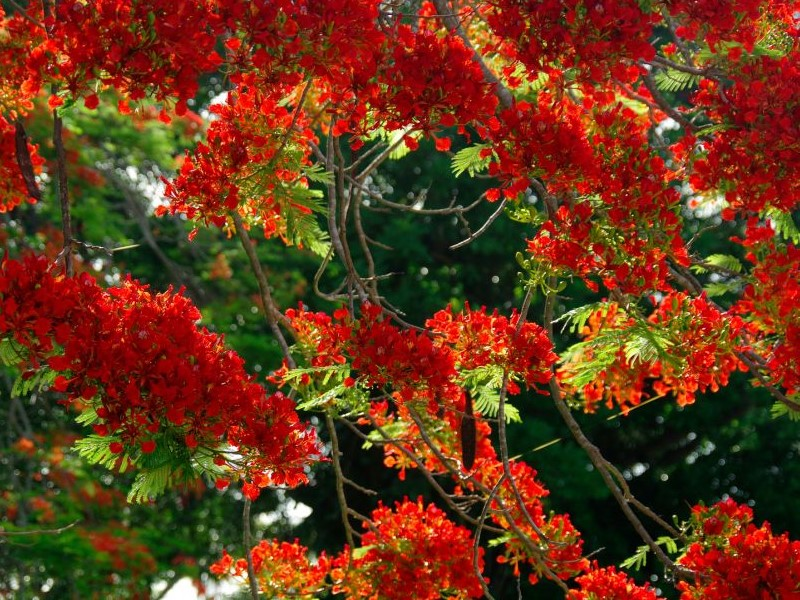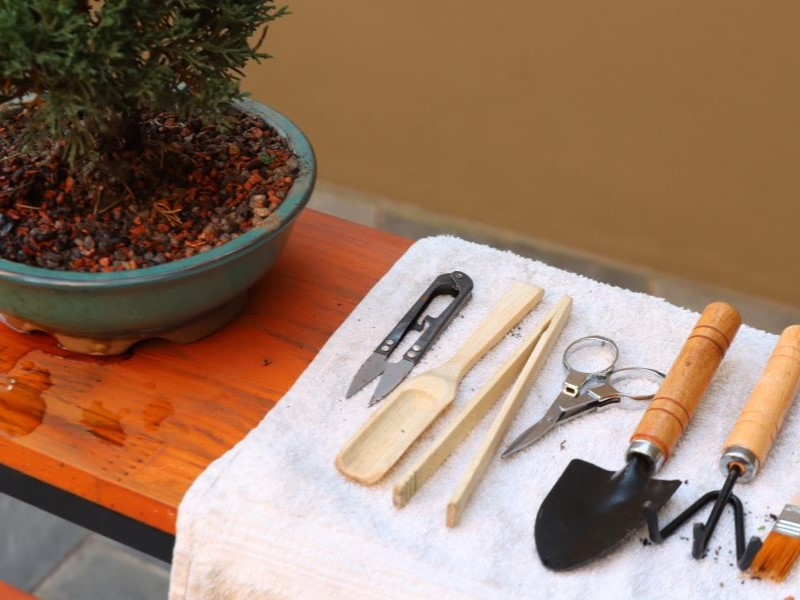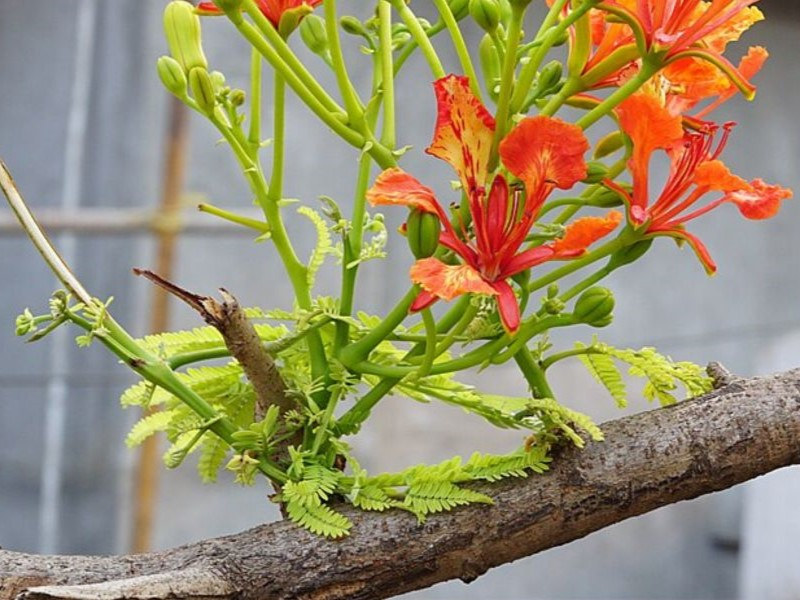Imagine a bonsai that ignites passion in every leaf, a miniature marvel that mirrors the grandeur of full-sized flame trees. Flame Tree Bonsai is no ordinary creation—it’s a living canvas ablaze with vibrant hues, a symphony of elegance in miniature form.
From the fiery bursts of color to the delicate branches that mimic nature’s grace, get ready for an exhilarating peek into the features of the Flame tree and the artistry that awaits.
Understanding Flame Trees

Flame Tree, scientifically named Delonix Regia and also called Royal Poinciana, introduces a tropical essence to the world of bonsai cultivation. With vibrant red or golden flowers, this bonsai variety brings a touch of the tropics to miniature gardening. The visual allure of this bonsai lies in its striking contrast of fiery blossoms against lush green foliage, creating a captivating spectacle during the warmer months from spring to summer.
Native to tropical and subtropical regions, this large deciduous tree demonstrates adaptability to warm climates, making it well-suited for bonsai enthusiasts. The carefully nurtured trunks, textured bark, and intricately shaped branches of this bonsai version echo the delicate beauty of its larger, tropical counterpart.
Remarkably low-maintenance, Flame tree withstands periods of drought and proves resilient against pests once established. This practicality enhances its appeal as an attractive and manageable choice for bonsai enthusiasts.
Distinctive Features of Flame Bonsai Tree
Flame bonsai tree unveils a captivating array of distinctive features contributing to its unique allure.
Fiery Blossoms
The hallmark of the Flame tree is vibrant red or golden flowers that create a visually striking display. Blossoms form in clusters, adding a flamboyant touch to the bonsai’s aesthetic.
Elegant Trunk Structure
The Royal Poinciana Bonsai exhibits a refined silhouette with a sturdy and gracefully contoured trunk. The trunk’s elegance adds a sense of maturity and timeless charm to the overall composition.
Graceful Leaf Arrangement
Delicate, fern-like leaves cascade in a compound arrangement, creating a lush and balanced canopy. Leaflets follow a symmetrical pattern, enhancing the bonsai’s overall grace and visual appeal.
Seasonal Color Transitions
Throughout the seasons, the Royal Poinciana undergoes dynamic color transformations. From vibrant greens in spring and summer to warm hues of red and gold in autumn, the bonsai offers a visually captivating journey.
Fine Textured Bark
The bark of the Royal Poinciana is characterized by a fine texture, adding a tactile element to its aesthetic charm. The bark develops unique patterns as the bonsai matures, showcasing the tree’s evolving character.
Choosing the Right Flame Tree Species for Bonsai
Selecting the appropriate species is pivotal when venturing into Flame Tree Bonsai cultivation. Among the popular choices for bonsai enthusiasts are the Delonix Regia (Royal Poinciana) – the most popular choice, Brachychiton Acerifolius (Illawarra Flame Tree), and Brachychiton Rupestris (Queensland Bottle Tree), each offering distinct characteristics and visual appeal to enhance a bonsai collection.
The decision-making process involves careful consideration of critical factors. First and foremost, compatibility with the climate of your region is vital. While some flame tree varieties flourish in warm tropical conditions, others exhibit adaptability to a broader range of temperatures.
Additionally, assessing the available space for your bonsai is crucial, as certain species may require more room due to their expansive growth. In contrast, others maintain a more compact form suitable for smaller areas. Your skill level in bonsai cultivation is also a critical factor. Beginners might succeed with more forgiving species like the Royal Poinciana or Illawarra Flame Tree, while advanced enthusiasts may be drawn to species with more intricate care requirements.
Practical advice for selecting a flame tree species revolves around balancing personal preferences and practical considerations. Beginners might succeed with resilient species like the Royal Poinciana or Illawarra Flame Tree. Seeking guidance from local bonsai enthusiasts or experts can also provide valuable insights tailored to your specific climate and conditions.
Essential Tools and Supplies

Caring for your Flame Tree involves a straightforward toolkit and practical tips to ensure its health and beauty. Begin with sharp pruning shears for precise trimming, promoting a well-shaped and balanced bonsai.
Utilize well-draining soil crafted from a simple mix of organic and inorganic components and a watering can with a fine spout for consistent watering. Shape and style your bonsai with training wire, choosing a bonsai pot with drainage holes to promote healthy growth of roots. A root hook facilitates periodic root checks and pruning. Opt for a balanced, solid fertilizer with an N-P-K ratio, applying it at half-strength during the growing season. These tools and supplies are essential for effective bonsai care.
Cultivating Flame Tree Bonsai: A Step-by-Step Guide
Cultivating your Flame Tree is a straightforward and rewarding process. Follow these practical steps to ensure the health and beauty of your miniature tree.
1. Flame Tree Selection
- Choose a young and healthy Flame Tree from a reputable source.
- Ensure it is well-suited to your local climate conditions.
2. Soil and Container Setup
- Opt for well-draining bonsai and slightly acidic soil.
- Plant your bonsai in a suitable container with drainage holes.
3. Watering Routine
- Adhere to a consistent watering schedule to support robust flower development
- Water the bonsai thoroughly, allowing the soil to dry slightly between waterings.
- Avoid overwatering, which can cause root rot.
4. Pruning Practices
- Use sharp pruning shears to trim unwanted branches.
- Maintain a balanced shape, avoiding removing too many leaves at once.
- Remove spent flowers judiciously to promote continuous and vigorous blooming.
5. Training with Wire
- Gently use training wire to guide branches into the desired form.
- Regularly check and adjust the wire to prevent damage as the tree grows.
6. Feeding Your Bonsai
- Apply a balanced, solid fertilizer during the growing season.
- Apply a flower-friendly fertilizer with a balanced N-P-K ratio suitable for Flame bonsai trees.
- Administer the fertilizer at half the recommended strength to avoid overfeeding.
7. Repotting Routine
- Repot the bonsai every two to three years to refresh the soil.
- Promote overall root health and prevent overcrowding.
8. Sunlight Exposure
- Flame tree prefers a location with direct sunlight for a few hours daily.
- Shield it from extreme weather conditions.
9. Pest and Disease Management:
- Regularly inspect the bonsai for pests and diseases.
- Address issues promptly with suitable treatments.
10. Patience and Enjoyment:
- Embrace the gradual development of your tree.
- Enjoy the process and the beauty it brings to your space.
Common Challenges and How to Overcome Them
Having a Flame tree comes with its share of challenges, each demanding thoughtful solutions. Limited flowering, often from insufficient sunlight or poor nutrition, necessitates proper sunlight exposure and a balanced, flower-friendly fertilizer during the growing season. Addressing yellowing leaves involves adjusting the watering routine, ensuring adequate drainage, and considering a well-balanced fertilizer. Pests and diseases constantly threaten, demanding regular inspection and prompt treatment.
Root constriction, a natural occurrence over time, calls for periodic repotting, and maintaining the tree’s shape requires regular pruning while protecting it from extreme weather events to ensure its overall health. Consistent attention to soil quality and proper watering practices, along with a keen understanding of pruning techniques, contribute to the longevity and aesthetic appeal of the Flame tree, transforming it into a thriving and captivating miniature tree.
Flame Tree in Different Seasons

The appeal of this bonsai extends across various seasons, each presenting unique characteristics and care requirements. The tree bursts into life in early spring with fiery red or golden flowers, creating a captivating spectacle. During this season, careful attention to sunlight exposure and nutrient-rich soil is crucial to support the vibrant blossoms. As summer unfolds, the bonsai’s foliage continues to flourish, and regular watering becomes paramount to combat the heat and maintain overall health.
In autumn, the bonsai transitions, with the vibrant green leaves transforming into a rich array of warm hues. Pruning during this season aids in maintaining the desired shape and encourages healthy growth for the upcoming year. As winter approaches, a protective system is necessary to shield the bonsai from potential frost and extreme cold. Adjusting watering routines and providing additional insulation ensures the bonsai remains resilient in winter challenges.
Conclusion: Nurturing Your Flame Tree Bonsai Journey
Growing a thriving bonsai flame tree is a journey of simplicity and dedication. Each step contributes to the overall well-being of your miniature masterpiece, from carefully selecting a healthy tree to the mindful practices of watering, pruning, and fertilizing. Adapt your care routine as seasons change, protecting the bonsai during challenging weather and maintaining a watchful eye for potential issues.
The essence of nurturing your Royal Poinciana Bonsai lies in the ongoing commitment to its health and aesthetics. Embrace the evolving beauty of blossoms and foliage, and allow the bonsai to reflect your attentive care. May this journey bring continuous joy and a harmonious connection with cultivating a resilient and captivating miniature tree.





0 Comments